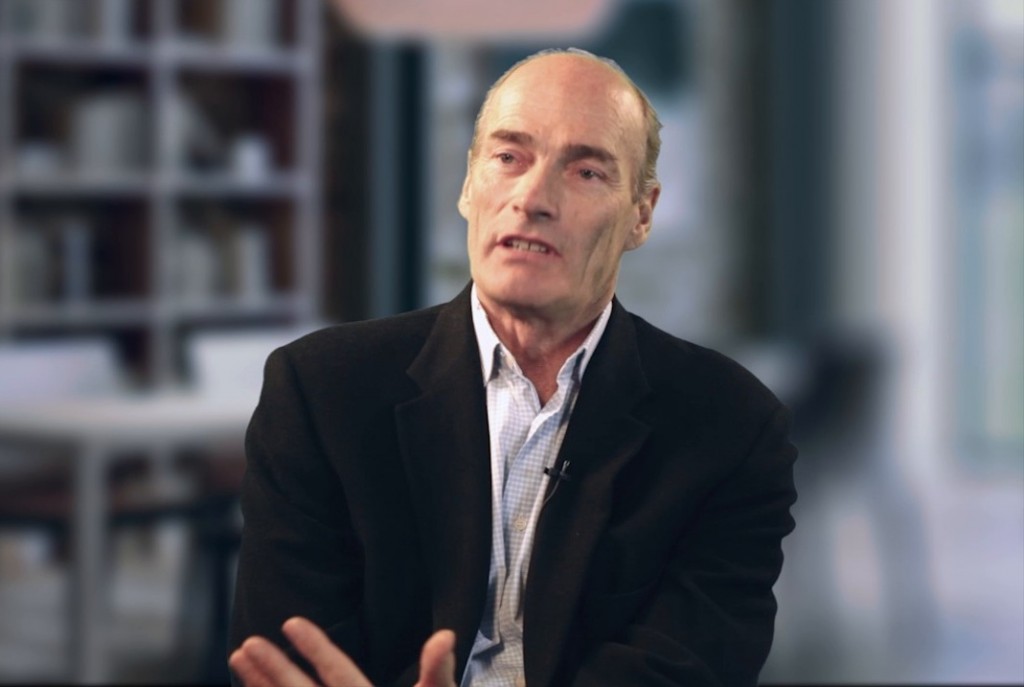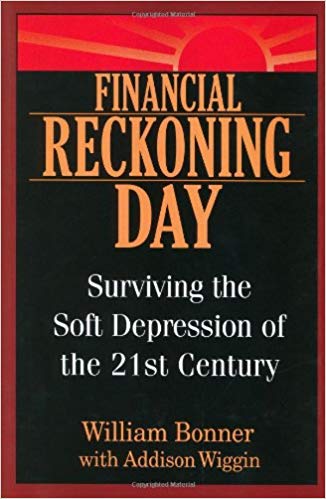Financial Reckoning Day Summary
7 min read ⌚
 Surviving the Soft Depression of the 21st Century
Surviving the Soft Depression of the 21st Century
What if someone told you that there are serious indicators attesting that we are experiencing the beginning of the end of American capitalism?
And what if that same guy added that, in fact, American capitalism wasn’t that great to begin with – but just another case of plain old dumb luck?
You may have second thoughts whether you should listen to that guy even a second more – probably just another time-forsaken communist, right? – but William Bonner and Addison Wiggin are anything but.
And, at least at first glance, they offer a strong case in “Financial Reckoning Day.”
Who Should Read “Financial Reckoning Day”? And Why?
“Financial Reckoning Day” references almost everyone from Adam Smith to Robert Merton, and from Freud to Einstein. In other words, it’s not exactly an easy read, but, strangely enough, it’s not a difficult one either.
Those who are interested in economics will certainly find here many things to think about. Those who are not – may find a reason to be.
About William Bonner and Addison Wiggin
 William “Bill” Bonner is an American author of articles and books on economic and financial topics.
William “Bill” Bonner is an American author of articles and books on economic and financial topics.
He is also the founder and president of Agora Inc. and the driving force behind its email newsletter The Daily Reckoning.
Bonner has co-authored two bestsellers with Addison Wiggin, the other one being “The New Empire of Debt” (in two editions). In addition, he has co-authored “Mobs, Messiahs, and Markets” with Lila Rajiva and “Family Fortunes” with his son, Will Bonner.
Independently, he is the author of “Hormeggedon” and, most recently, “Dice Have No Memory.”
 Addison Wiggin is an American financial author and filmmaker.
Addison Wiggin is an American financial author and filmmaker.
Executive publisher of Agora Financial, he is a long-time friend and collaborator of Bill Bonner, with whom he has co-authored two books.
In addition, he has co-authored “I.O.U.S.A.” (with Kate Incontrera) and written “Demise of the Dollar” and “The Little Book of the Shrinking Dollar.”
“Financial Reckoning Day PDF Summary”
Back in 1989, Francis Fukuyama published a widely discussed essay titled “The End of History?” on the pages of the renowned international affairs journal, “The National Interest.”
Inspired by the events happening in Eastern Europe and Germany at the time, Fukuyama had an interesting case to make:
What we may be witnessing is not just the end of the Cold War, or the passing of a particular period of post-war history, but the end of history as such: that is, the end point of mankind’s ideological evolution and the universalization of Western liberal democracy as the final form of human government.
One dot-com bubble and another financial crisis later, and not even Fukuyama himself currently believes his barely three decades old own prediction! In fact, in retrospect, it couldn’t have been further from the truth!
The truth – in the opinion of Bill Bonner and Addison Wiggin – has much more to do with luck than it has to do with smart organization.
Let’s look at the twentieth century, they say, but this time, without prejudice or partiality.
The United States currently accounts for about one-fifth of the world’s economy, but back in 1870 it accounted for no more than a tenth – a little less than what the United Kingdom did at the time; China accounted for more than twice as much.
The US economy grew during the next half a century, and most of the other economies stagnated, which resulted in the country being one of the richest in the world before the start of the First World War.
However, neither that war, nor the next one, were as gentle to USA’s competitors as they had been to the United States themselves.
As you probably already know, the US lost about half a million people in both wars combined and emerged from them without a single decimated city. For comparison, France lost six million people in World War I and the Soviet Union and Germany at least thrice as much in the Second World War only.
Needless to add, whole cities were ravaged throughout Eurasia, and industrial complexes had been irretrievably devasted.
In a nutshell, even though the United States did become the largest national economy in the 20th century, don’t you think that another European country would have achieved something similar if it hadn’t been bombarded and
What followed next was the Cold War during which – and don’t forget that – the Soviet Union was surely an enemy to fear from: its often ridiculed economy accounted for 20% of the world’s GDP in 1966!
At that time, the Soviets – and even the North Koreans! – believed that communism has brought not only the end of capitalism but the end of history as well. But we all know how that ended two decades later, don’t we?
Cue for rereading the Fukuyama quote above.
Notice the cycle?
Things are going great, everybody believes in progress and ultimate victory, and then everything goes down in blood and mud and flames!
Well, brace yourself for a somewhat similar future!
How do Bonner and Wiggin know this?
Well, because the US economy seems to freakishly closely mirror the Japanese economic miracle, offset by a decade.
The Japanese bull market began in 1971; the US in 1981. Stock market value increased by 500% by 1985 in Japan and by 1995 in the United States. Within the next five years, it increased three-fold in both countries, peaking in 1990 in Japan and at the turn of the millennium in the United States.
Who would have guessed back then – when everybody was investing in everything with .com at the end – that merely a year and a half later, the U.S. stock market would drop about 30%! The Japanese, interestingly, lost almost the same amount of value by the third quartal of 1991.
Supposedly, the Americans fared better during the next decade because of their consumerism: tight-fisted spending should have been the thing that hurt Japan.
But it isn’t: it’s simply the way the current economic system works. Too much optimism is never a good thing, especially if history has been kind to you; because it will certainly come back and hit you on the head.
Don’t forget: this book was written before the financial crisis of 2008 which it all but predicts: “…when those bubbles burst, it’s going to be worse than the stock market bubble, because there are many more people who are involved in consumption and housing.”
Key Lessons from “Financial Reckoning Day”
1. The Cold War Was a Battle Between Myths
2. The Trouble of the Market
3. The Damning Relation Between Economics and Demography
The Cold War Was a Battle Between Myths
You’ve already heard a lot about how the idea of a communist society was always a myth. However, barely half a century ago, a large part of the world firmly believed in this myth.
Well, capitalism is another myth based on the very same premise: the one of constant progress.
Constant progress is impossible and the fact that the US has experienced it for a century is merely evidence that things will soon deteriorate.
In a nutshell: don’t believe all those George Gilders out there!
The Trouble of the Market
The case of LTCM should be a lesson for everybody: the market is irrational, and there’s no way to predict it. In the words of Keynes, it can stay irrational much longer than an investor can remain solvent:
The trouble is that the market may look mechanistic, but it is not. The market is an unbounded, organic system; mastering it is a human science, not a hard science.
The Damning Relation Between Economics and Demography
Historian Jack Andrew Goldstone, in his book “Revolution and Rebellion in the Early Modern World,” argues that the fall of three empires (the Ottoman, the Chinese, and the Japanese) occurred because of population growth.
Currently, we have one even more serious problem: in the developed world, old people live far too long for the current social institutions to work.
Will we learn how to be flexible before it’s too late?
Like this summary? We’d like to invite you to download our free 12 min app for more amazing summaries and audiobooks.
“Financial Reckoning Day Quotes”
History shows that people who save and invest grow and prosper, and the others deteriorate and collapse. Share on X
Policies being pursued at the Fed are making the bubble worse. They are changing it from a stock market bubble to a consumption and housing bubble. Share on X
The consumer was the last man standing in the U.S. economy. Greenspan was compelled to do all he could to hold him upright, even if he was already dead. Share on X
The average boomer came of prime ’stock-buying’ age in the years when all good things seemed not just possible, but inevitable. Share on X
Most economists will tell you that the economic system is controlled by mood changes at the Fed. Share on X
Our Critical Review
“Financial Reckoning Day” was first published a decade and a half ago and, in few years’ time, one of its predictions came true: the United States (and the world) was hit by a serious financial crisis.
Now, if Bonner and Wiggin are right, that’s bound to happen again; and again; and again.
So, excuse us for reserving our judgment for now.
Because if it does, then this one will definitely go down in history as one of the most prophetic and visionary economics books ever written.
If, however, it doesn’t, then “Financial Reckoning Day” is hardly anything more than those apocalyptic religious prophecies (not that dissimilar from the Mayan 2012 phenomenon) which tend to scare a few people from time to time before turning into ingenious memes and the laughing-stock of multitudes.
Emir is the Head of Marketing at 12min. In his spare time, he loves to meditate and play soccer.


 Surviving the Soft Depression of the 21
Surviving the Soft Depression of the 21




